In the arrangement shown in the fig. a monkey of mass M keeps itself as well as block A at rest by firmly holding the rope. Rope is massless and the pulley is ideal. Height of the monkey and block A from the floor is h and 2h respectively [h = 2.5 m]
(a) The monkey loosens its grip on the rope and slides down to the floor. At what height from the ground is block A at the instant the money hits the ground?
(b) Another block of mass equal to that of A is stuck to the block A and the system is released. The monkey decides to keep itself at height h above the ground and it allows the rope to slide through its hand. With what speed will the block strike the ground?
(c) In the situation described in (b), the monkey decides to prevent the block from striking the floor. The monkey remains at height h till the block crosses it. At the instant the block is crossing the monkey it begins climbing up the rope. Find the minimum acceleration of the monkey relative to the rope, so that the block is not able to hit the floor. Do you think that a monkey can climb with such an acceleration? (g=10ms−2)
![In the arrangement shown in the fig. a monkey of mass M keeps itself as well as block A at rest by firmly holding the rope. Rope is massless and the pulley is ideal. Height of the monkey and block A from the floor is h and 2h respectively [h = 2.5 m] (a) The monkey loosens its grip on the rope and slides down to the floor. At what height from the ground is block A at the instant the money hits the ground? (b) Another block of mass equal to that of A is stuck to the block A and the system is released. The monkey decides to keep itself at height h above the ground and it allows the rope to slide through its hand. With what speed will the block strike the ground? (c) In the situation described in (b), the monkey decides to prevent the block from striking the floor. The monkey remains at height h till the block crosses it. At the instant the block is crossing the monkey it begins climbing up the rope. Find the minimum acceleration of the monkey relative to the rope, so that the block is not able to hit the floor. Do you think that a monkey can climb with such an acceleration? (g = 10ms^(-2))](https://d10lpgp6xz60nq.cloudfront.net/physics_images/IJA_PHY_V01_C03_E01_054_Q01.png)
The correct Answer is:(a) The block is at height h = 2.5
(b) V=5√2m/s
25m/s2↑⏐
Step by step video, text & image solution for In the arrangement shown in the fig. a monkey of mass M keeps itself as well as block A at rest by firmly holding the rope. Rope is massless and the pulley is ideal. Height of the monkey and block A from the floor is h and 2h respectively [h = 2.5 m] (a) The monkey loosens its grip on the rope and slides down to the floor. At what height from the ground is block A at the instant the money hits the ground? (b) Another block of mass equal to that of A is stuck to the block A and the system is released. The monkey decides to keep itself at height h above the ground and it allows the rope to slide through its hand. With what speed will the block strike the ground? (c) In the situation described in (b), the monkey decides to prevent the block from striking the floor. The monkey remains at height h till the block crosses it. At the instant the block is crossing the monkey it begins climbing up the rope. Find the minimum acceleration of the monkey relative to the rope, so that the block is not able to hit the floor. Do you think that a monkey can climb with such an acceleration? (g = 10ms^(-2)) by Physics experts to help you in doubts & scoring excellent marks in Class 11 exams.
Topper's Solved these Questions
Similar Questions
A particle is acted upon by a force for 1 second whose X component remains constant at Fx=30N but y and z components vary with time as shown in the graph. Calculate the magnitude of change in momentum of the particle in 1 s. What angle does the change in momentum (Δ→P) make with X axis ?
 05:52View Solution
05:52View SolutionThe pulley of radius R can rotate freely about its axle as shown in the figure. A thread is tightly wrapped around the pulley and its free end carries a block of mass m. When the block is at a height h above the ground the system is released (i.e., the pulley is made free to rotate & the block is allowed to fall) and at the same instant the axle is moved up keeping it horizontal all the time. When the block hits the floor the axle has gone up by a distance 2h. Find the angle by which the pulley must have rotated by this time.
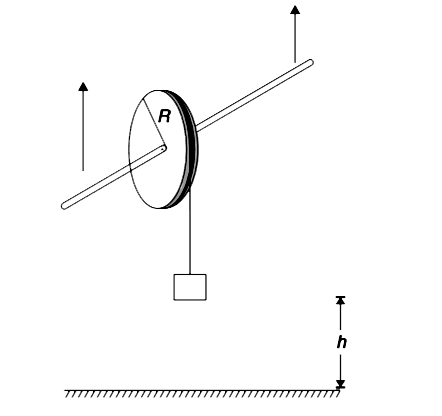 10:06View Solution
10:06View SolutionA monkey is climbing on a rope that goes over a smooth light pulley and supports a block of equal mass at the other end. Show that whatever force the monkey exerts on the rope, the monkey and the block move in the same direction with
06:51View SolutionThe monkey B shown in figure is holding on to the tall of the monkey A which is climbing up a rope. The masses of the monkeys A and B are 5 kg and 2kg respectively. If A can tolerate a tension of 30 N in its tail what force should it apply on the rope in order to carry the monkey B with it? Take g=10,ms2.
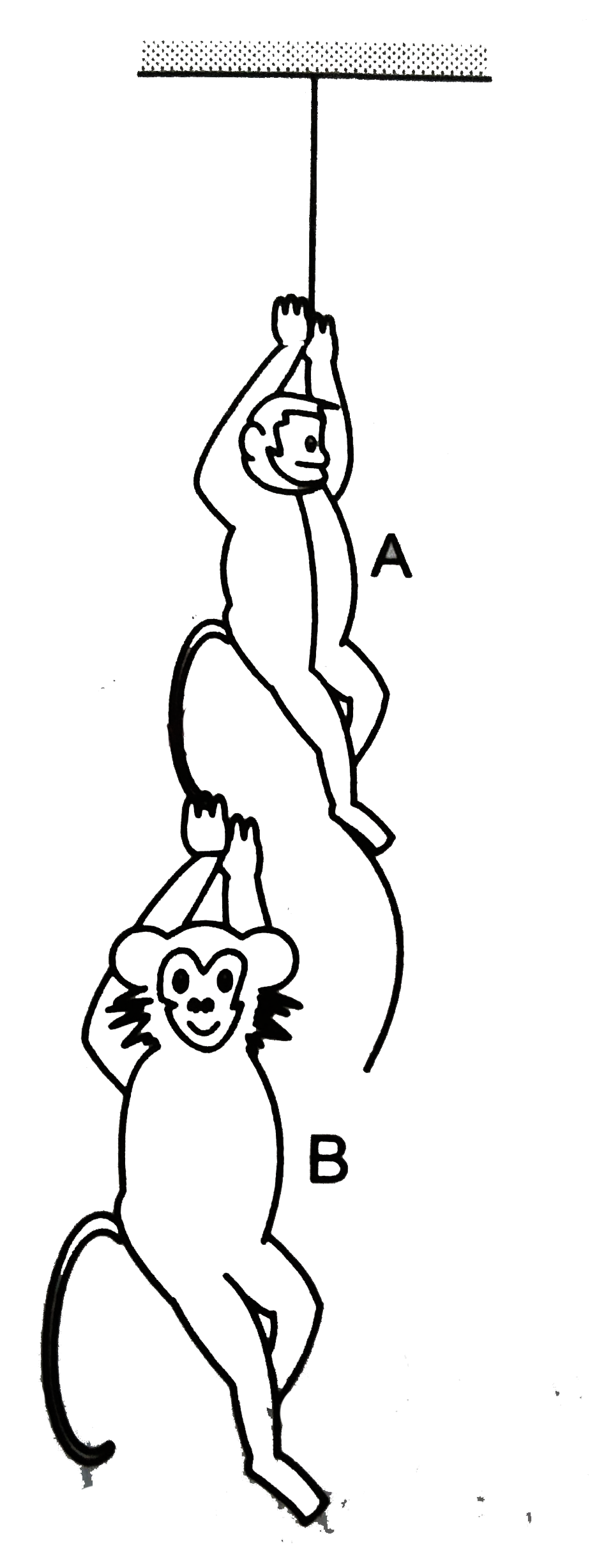 02:57View Solution
02:57View SolutionThe ballon the light rope and the monkey shown in figure are at rest in the air. If the monkey reaches the top of the rope, by what distnce does the ballon descend? Mass of the ballon =M mass of the monkey =m and the length of the rope ascended by the monkey =L
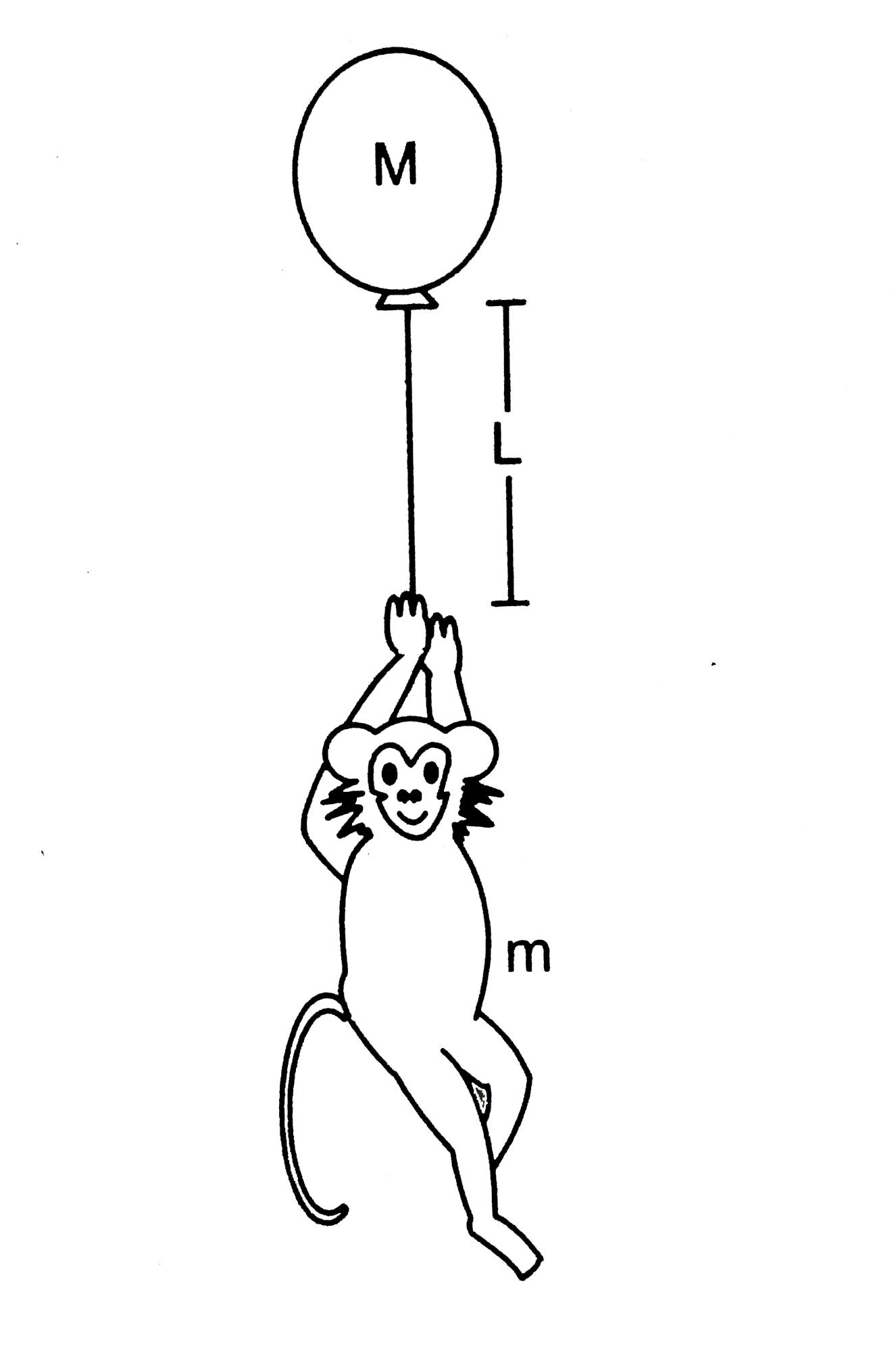 01:36View Solution
01:36View SolutionA monkey of mass m clings a rope to a slung over a fixed pulley .The opposite end of the rope is tried to a weight of mass M tying on a horizontal table is μ Find the acceleration of weight and the tension of the rope for two cases .The monkey move downward with respect to the rope with an acceleration b.
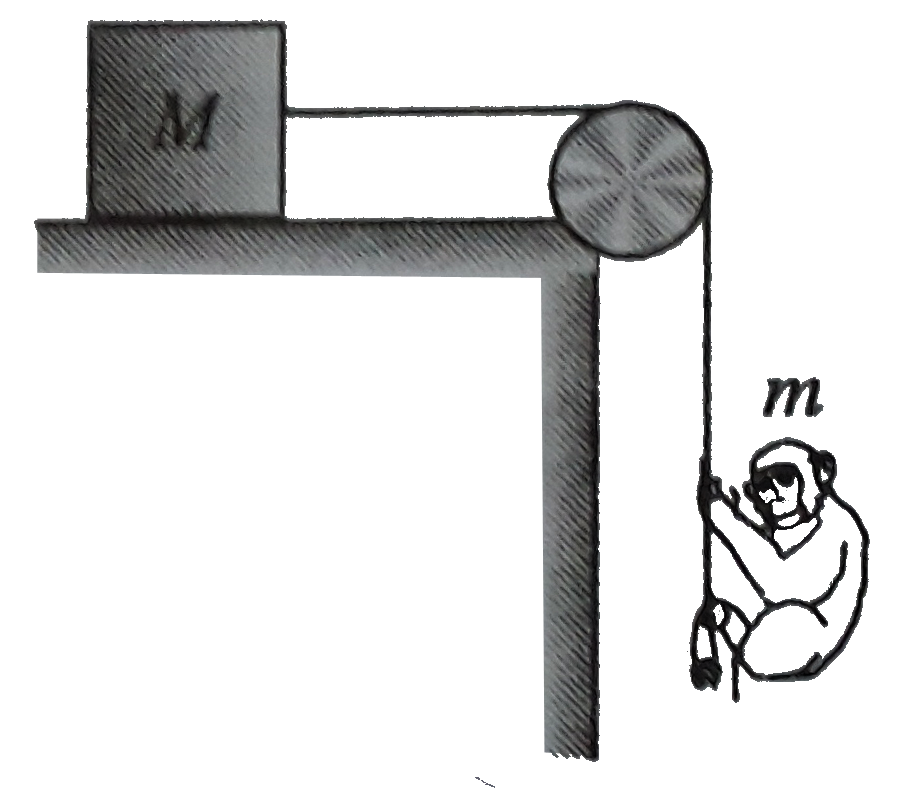
The tension of rope is04:12View SolutionA monkey of mass 40kg climbs on a massless rope of breaking strenght 600N . The rope will break if the monkey (Take g =10 m//s^(2) ) .
04:02View SolutionA monkey of mass m climbs up to a rope hung over a fixed pulley. The opposite end of the rope is tied to a weight of mass M lying on a horizontal plane. Neglecting the friction, find the acceleration of both the bodies (relative to the plane) and the tension of the rope for the three cases:
(i) The monkey does not move with respect to the rope
(ii) The monkey moves upwards with respect to the rope with acceleration a.
(iii) The monkey moves downwards with respect to the rope, with acceleration a.04:38View Solutionचित्र में दिखाए गए बैलून,रस्सी एवं बंदर ,सभी स्थित है | बैलून का द्रव्यमान M, बंदर का द्रव्यमान m तथा रस्सी का द्रव्यमान नगण्य है| बैलून तथा बंदर के बीच रस्सी कि लम्बाई L है | यदि बंदर रस्सी पर चढ़ता हुआ बैलून तक पहुँच जाए, तो बैलून कितना दूर नीचे उतरेगा ?
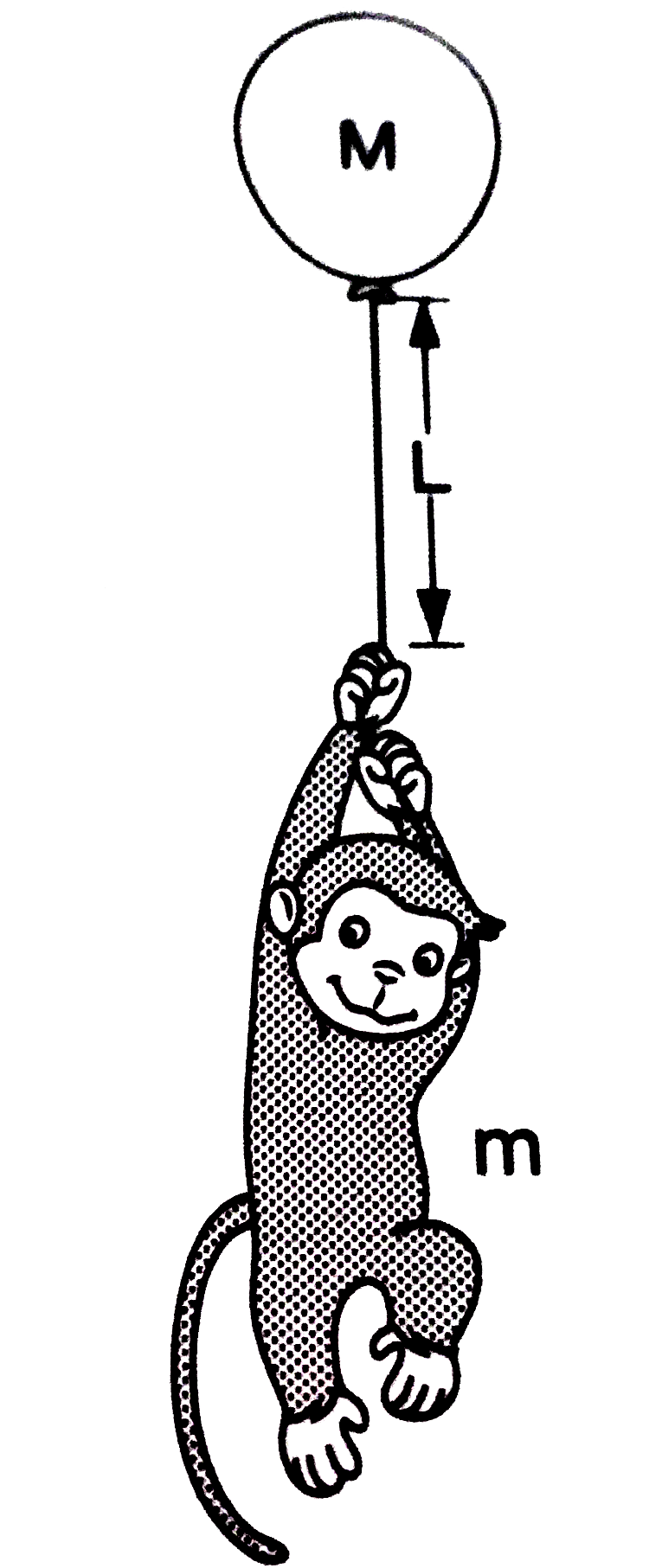 View Solution
View SolutionA balloon of mass M with a light rope having monkey on the rope is in equilibrium. If the monkey starts moving up with acceleration a w.r.t. rope . Then the acceleration of cenre of mass of the system is
05:30View SolutionA monkey of mass 40 kg climbs on a massless rope of breaking strength 600 N. The rope will break if the monkey. (Take g=10m/s2)
03:21View SolutionA Monkey is Climbing on a Rope that Goes Over a Smooth Light Pulley and Supports a Block of Equal Mass at the Other End in the Following
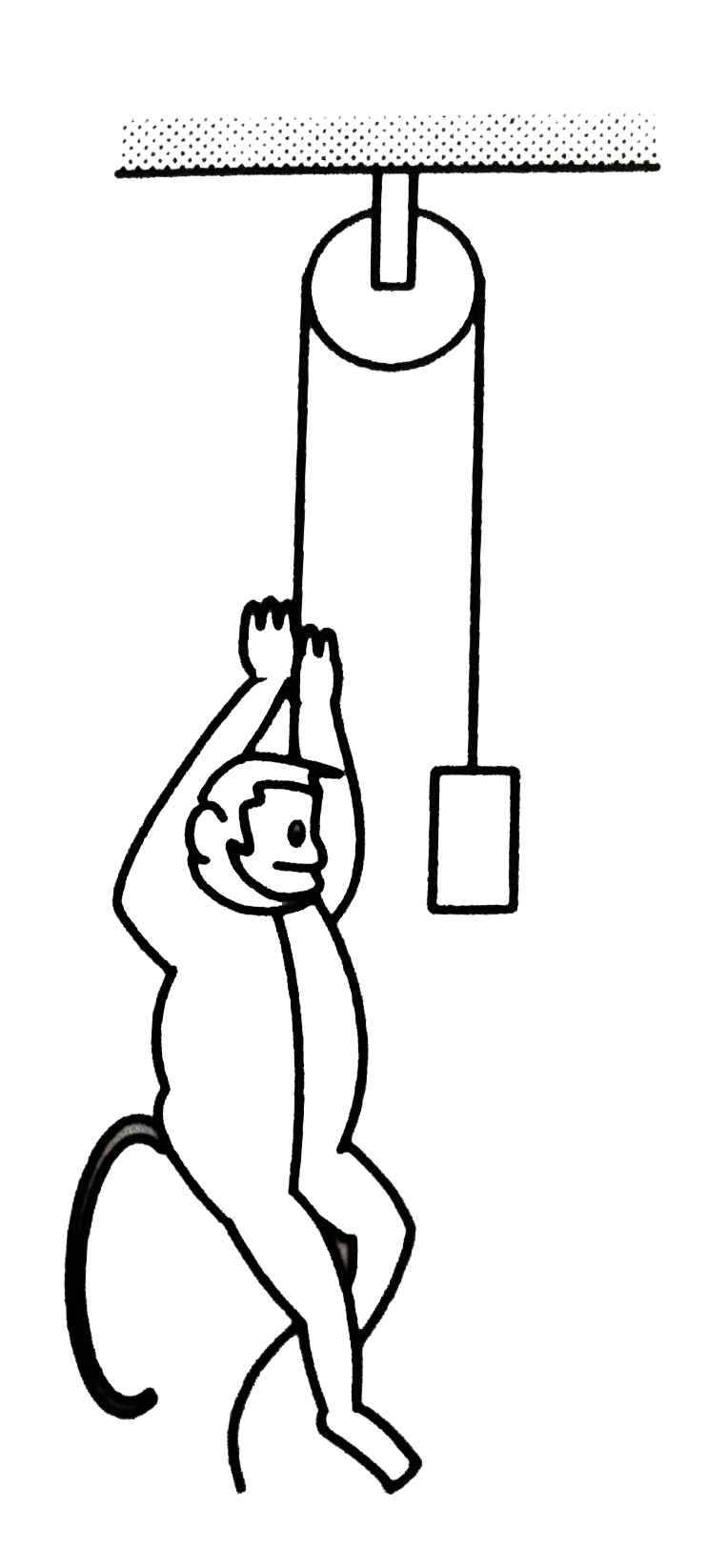 View Solution
View SolutionThe ballon the light rope and the monkey shown in figure are at rest in the air. If the monkey reaches the top of the rope, by what distnce does the ballon descend? Mass of the ballon =M mass of the monkey =m and the length of the rope ascended by the monkey =L
 View Solution
View SolutionA monkey of mass m clings to a rope over a fixed pulley. The opposite ends of the rope is tide to a weight of mass M lying on a horizontal plate neglecting friction, find the acceleration of both bodies relative to the plate and tension of the rope in the following cases:
i) the monkey does not move with respect to rope.
ii) the monkey moves upwards with respect to rope with acceleration β .
iii) the monkey moves downwards with respect to the rope with acceleration β.
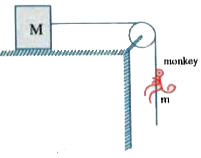 03:44View Solution
03:44View SolutionA monkey of mass m clings to a rope over a fixed pulley .
The opposite ends of the rope is tide to a weight of mass M lying on a horizontal plate neglecting friction, find the acceleration of both bodies relative to the plate and tension of the rope in the following case:
(i)the monkey does not move with respect to rope.
(ii)the monkey moves upwards with respect to rope with acceleration β
(iii) the monkey moves downwards with respect to the rope with acceleration β
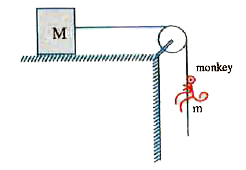 04:37View Solution
04:37View Solution

